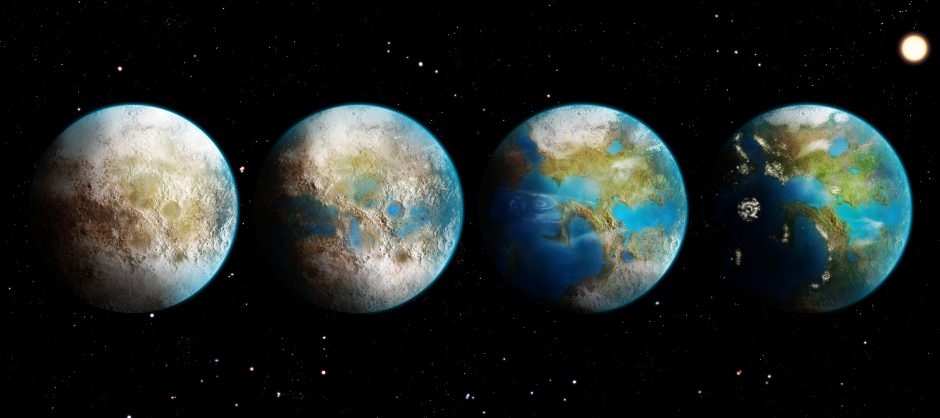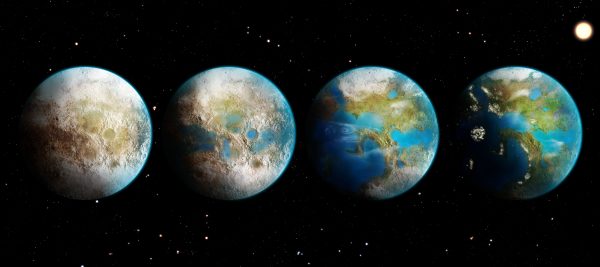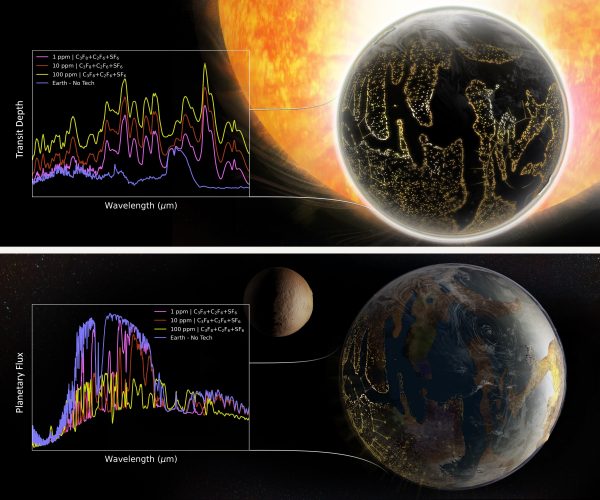Telltale greenhouse gases could signal alien activity

Known for their detrimental effect on Earth, greenhouse gases could be beneficial for alien civilizations afar to terraform their worlds, and an opportunity for us to spot them. An international team of scientists including Dr. Daniel Angerhausen from ETH Zurich and member of the National Centre of Competence (NCCR) PlanetS, calculated that current technology would have the capacity to detect such greenhouse gases in close-by planetary system. The study, published in the Astrophysical Journal, also found the prospects of such a discovery even further away from our Solar System will be greatly increased with the next generation of space-based telescopes under development, such as the LIFE (Large Interferometer For Exoplanets) mission led by ETH Zurich. If aliens modified a planet in their stellar system to make it warmer, we will be able to tell.
For astrophysicists, liquid water at the surface is one of the most important parameters for a planet to have the potential to harbor life, or not. This in turn requires an ideal average temperature which is highly dependent on a planet’s atmospheric composition. Of course, an intelligent alien civilization colonizing new planets and moons in their stellar system might overcome temperature-related problems thanks to technology. However, to walk freely at the surface they might choose a more subtle and long-term approach: climate engineering. In such a scenario, they could influence their atmospheric composition using greenhouses gases to warm up a frozen world. UC Riverside has led an international team of scientists to study such scenarios and what detectable imprint they could create. The team determined that such gases could be detectable in exoplanetary atmospheres even at relatively low concentrations, and already with current technology like the James Webb Space Telescope (JWST). “In the mid-term future we could even search for these signals systematically with LIFE, a European-lead space telescope concept which we are currently developing at ETH Zurich,” declared Dr. Daniel Angerhausen, astrophysics at ETH Zurich and the NCCR Planets, and co-author of the study.

Greenhouse gases could be used by alien civilizations to terraformed their Earth-like planet or moon and slowly bring it from an icy desertic ball (left), all the way to a temperate and inhabited planet (right). The gases needed for such a process could be discussed by current and future space-telescopes. Credit: Thibaut Roger/NCCR PlanetS
Carefully choosing your greenhouses gases
While greenhouse gases are considered pollutants and must be controlled on Earth to prevent harmful climate effects, there are reasons they might be used intentionally on an exoplanet: a planet orbiting another star than our Sun.
“For us, these gases are bad because we don’t want to increase warming. But they’d be good for a civilization that perhaps wanted to forestall an impending ice age or terraform an otherwise uninhabitable planet in their system, as humans have proposed for Mars,” said UCR astrobiologist and lead study author Edward Schwieterman.
Since these gases are not known to occur in significant quantities in nature, they must be manufactured. Finding them, therefore, would be a sign of intelligent, technology-using life forms. Such signs are called technosignatures. The researchers are proposing specifically five gases used on Earth in industrial applications such as making computer chips. They include fluorinated versions of methane, ethane, and propane, along with gases made of nitrogen and fluorine or sulfur and fluorine.
One advantage is that they are incredibly effective greenhouse gases. Sulfur hexafluoride (SF6), for example, has 23,500 times the warming power of carbon dioxide. A relatively small amount could heat a freezing planet to the point where liquid water could persist on its surface. Another advantage of the proposed gases — at least from an alien point of view — is that they are exceptionally long-lived and would persist in an Earth-like atmosphere for up to 50,000 years. “They wouldn’t need to be replenished too often for a hospitable climate to be maintained,” Schwieterman said. “The long lifetime also makes it an excellent technosignature to systematically search for in comparison to only short-lived signals. These signatures might even outlive their civilization if the geo-engineering experiments fail.” added Angerhausen.
Others have proposed refrigerant chemicals, CFCs, as technosignature gases because they are almost exclusively artificial and visible in Earth’s atmosphere. However, CFCs may not be advantageous because they destroy the ozone layer, unlike the fully fluorinated gases discussed in the new paper, which are chemically inert.
“If another civilization had an oxygen-rich atmosphere, they’d also have an ozone layer they’d want to protect,” Schwieterman said. “CFCs would be broken apart in the ozone layer even as they catalyzed its destruction.” As they’re more easily broken apart, CFCs are also short-lived, making them harder to detect.
Observing in the mid-infrared
Manufactured greenhouses gases modify the climate of an Earth-like planet as they absorb the infrared light it emits or reflects, and prevent it from escaping to space, trapping heat in the atmosphere the planet. This creates a characteristic spectroscopic signature as only specific infrared colors are absorbed by the considered gases. Such spectroscopic observations of exoplanets are a very common way to determine the chemical composition of an exoplanetary atmosphere, and only minute amounts of the greenhouse gases are required to be both detectable and effective for an alien civilization to warm up their atmosphere.
To arrive at this calculation, the researchers simulated a planet in the TRAPPIST-1 system, about 40 light-years away from Earth. They chose this system, which contains seven known rocky planets, because it is one of the most studied planetary systems aside from our own. It is also a realistic target for existing space-based telescopes such as JWST to examine.
Angerhausen’s main contribution was the analysis of the European LIFE mission’s ability to detect the fluorinated gases around an even wider array of simulated exoplanets and host stars, including an Earth-like planet around a Sun-like star at 30 lightyears distance. The LIFE mission would be able to directly image planets using infrared light significantly expanding the discovery space compared to the Webb telescope that looks at planets as they pass in front of their stars. LIFE is an exciting space-based telescope concept in development at ETH Zurich under the leadership of Prof. Sascha Quanz. It uses not one but four telescopes, combining their light via interferometry in a fifth spacecraft to provide exquisite resolution of distant objects. ESA’s Darwin or NASA’s TPF-I mission concepts already explored this idea. LIFE builds on their heritage, leveraging the latest discoveries in exoplanet research and the latest technological developments, to further refine the concept and turn it into reality. “With the support of the NCCR PlanetS and the Swiss Space Office, we are currently working on NICE, a lab-based version of the instrument to show the technology is now mature enough to turn this concept into reality,” explains Prof. Sascha Quanz, leader of the project.

Qualitative mid-infrared transmission and emission spectra of a hypothetical Earth-like planet whose climate has been modified with artificial greenhouse gases. (Sohail Wasif/UCR)
Not a matter of probability
While the researchers cannot quantify the likelihood of finding these gases in the near future, they are confident that — if they are present — it is entirely possible to detect them during currently planned missions to characterize planetary atmospheres. “Independent of the question about the likelihood, this thought experiment shows how powerful our next generation telescopes are. We are the first generation in history that has the technology to systematically look for life and intelligence in our galactic neighborhood,” added Angerhausen.
“You wouldn’t need extra effort to look for these technosignatures, if your telescope is already characterizing the planet for other reasons,” said Schwieterman. “And it would be jaw-droppingly amazing to find them.”
This work, led by UC Riverside, was done in collaboration with an international team of researchers from NASA’s Goddard Space Flight Center, BMSIS, Paris University and from the ETH Zurich. This article is based on a press release from UC Riverside.
Categories: News
